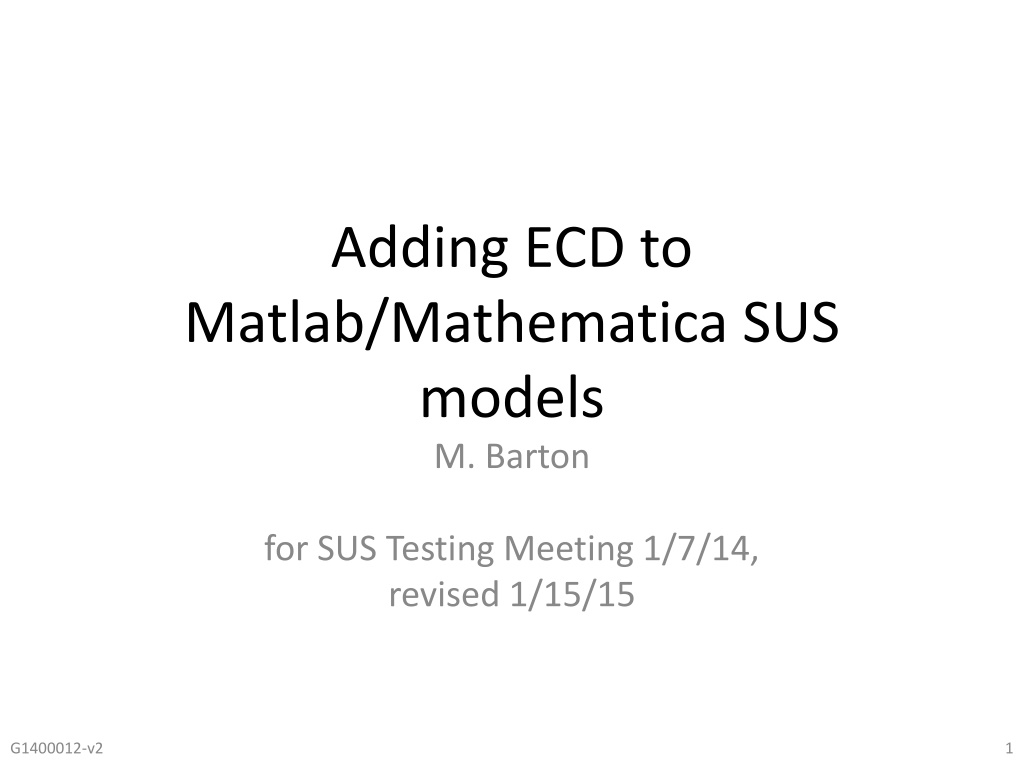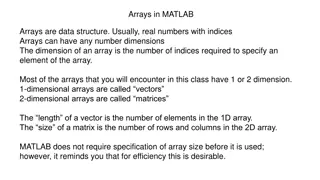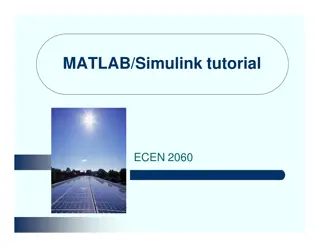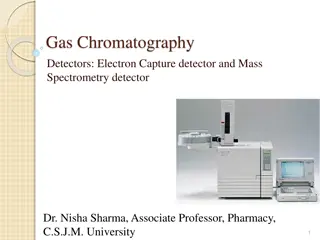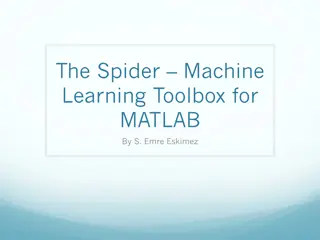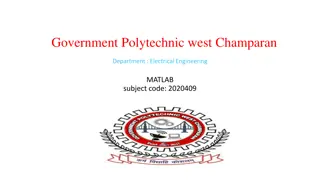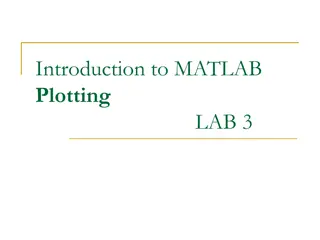Advancements in Adding ECD to Matlab/Mathematica SUS Models
Enhancements in incorporating Eddy Current Damping (ECD) into Matlab and Mathematica SUS models for HAUX/HTTS testing have been made to streamline the integration process. This includes addressing challenges with damping implementation, exporting symbolic matrices, and utilizing state-space formalism. Progress has been made in efficiently adding ECD, addressing compatibility issues, and improving numerical solutions for complex matrices. The latest updates have focused on refining the model frameworks and accommodating velocity damping components more effectively.
Uploaded on Sep 24, 2024 | 0 Views
Download Presentation

Please find below an Image/Link to download the presentation.
The content on the website is provided AS IS for your information and personal use only. It may not be sold, licensed, or shared on other websites without obtaining consent from the author.If you encounter any issues during the download, it is possible that the publisher has removed the file from their server.
You are allowed to download the files provided on this website for personal or commercial use, subject to the condition that they are used lawfully. All files are the property of their respective owners.
The content on the website is provided AS IS for your information and personal use only. It may not be sold, licensed, or shared on other websites without obtaining consent from the author.
E N D
Presentation Transcript
Adding ECD to Matlab/Mathematica SUS models M. Barton for SUS Testing Meeting 1/7/14, revised 1/15/15 G1400012-v2 1
Damping for HAUX/HTTS There is a suite of Matlab models for different suspension types, including a single pendulum with blades for HAUX/HTTS. None of these have built-in eddy current damping any damping has been added by wrapping a control system around the model in Simulink or the like. HAUX and HTTS have built-in ECD and it is inconvenient not having this as part of the model. Partial support was added a few months ago by hacking the state space A matrix. This was enough to support standard SUS testing by giving valid optic force/torque to optic displacement TFs. Rana et al. have requested support for structure displacement to optic displacement TFs. This was trickier, and required adding a set of new structure-velocity inputs and hacking the B matrix. The changes have been implemented but there is an outstanding bug. G1400012-v2 2
Status Quo Ante Each Mathematica model exports symbolic matrix elements in Matlab format, e.g., symbexport1bladesfull.m for single model with blades. Damping had not been exported due to incompatible representations. Mathematica uses frequency dependent complex matrixes acting on a state vector of (just) displacements. Can easily represent arbitrary frequency dependence, including structural, thermoelastic and velocity damping terms. Less convenient in time domain. Matlab uses state-space formalism Convenient for Matlab Simulink and linear analysis tools. Can only represent velocity damping. In principle, the velocity damping component of the total damping could be automatically exported from Mathematica, but historically hasn t been. => Re-add from scratch. G1400012-v2 3
Mathematica Equation of motion (T020205): fx-CXS(eff)s-snom Keff- 2p f x=xeq+ 2M x-xeq All matrices complex and/or frequency-dependent. Solved numerically for individual values of f. ECD can be added as a spring with damping factor 0+2 if. Curious sign of coupling matrix CXS(eff) is artifact of definition as submatrix of master stiffness matrix main entries are typically negative (see T020205). G1400012-v2 4
Matlab (Old) Usual Matlab model uses a state-space formulation: State is optic displacements and velocities. Inputs are structure displacements and direct forces/torques. Outputs are pendulum displacements and (optionally) reaction force. A/B equation becomes C/D equation becomes Velocity damping should go here in A matrix. No input, so no place to put in B matrix. G1400012-v2 5
Matlab (New A&B stuff) Velocity damping corner now filled out in A: New input, corresponding new column in B E matrix maps relative velocities to damping forces/torques. O matrix maps velocities at structure origin to velocities near ECD. 0 by 0 0 0 0 0 0 0 0 0 0 bx 0 -tl0 0 0 0 1 0 1 0 0 0 0 0 0 1 0 0 0 0 0 0 1 0 0 0 0 0 0 1 0 0 0 +tl0 0 0 0 1 0 0 0 0 0 0 0 bz 0 E = O= byaw 0 0 0 0 0 bpitch 0 0 0 0 0 broll is the "true length" from the suspension point down to the COM of the optic. tl0 Bug described in v1 of this presentation turned out to be a sign error in the LP term of O. G1400012-v2 6
Matlab (New C&D stuff) New o (for OSEM/ECD position) output, corresponding rows in C and D: New column in D for new input: As before with A and B, 1 0 0 0 -tl0 0 1 0 0 0 0 1 0 0 0 0 1 0 0 0 0 0 0 0 0 0 0 0 0 1 0 tl0 0 0 0 1 O= maps structure origin position or velocity to the position/velocity near the optic, and is the "true length" from the suspension point down to the COM of the optic. tl0 G1400012-v2 7
Matlab (New other stuff) New fields in penddata structure in hauxopt_damp.m: pend.B0xx = 0.5*pend.m0; pend.B0yy = 1.*pend.m0; pend.B0zz = 1.*pend.m0; pend.B0yawyaw = 0.05*pend.I0z; pend.B0pitchpitch = 2.*pend.I0y; pend.B0roll = 1.*pend.I0x; New stuff in ssmake1MBf_damp.m: E = diag([pend.B0xx,pend.B0yy,pend.B0zz, pend.B0yawyaw,pend.B0pitchpitch,pend.B0rollroll]); O = [1 0 0 0 -pend.tl0 0; 0 1 0 0 0 pend.tl0; 0 0 1 0 0 0; 0 0 0 1 0 0; 0 0 0 0 1 0; 0 0 0 0 0 1]; mbsingleA = [... zeros(6) eye(6) -km\(xm-cqxm'/qm*cqxm) -km\E ]; mbsingleC = [... eye(6) zeros(6,6) zeros(6,12) ]; bm1 = -km\(cxsm-cqxm'/qm*cqsm); bm2 = km\(E*O); bm3 = km\eye(6); mbsingleB = [... zeros(6,18) bm1 bm2 bm3 ]; mbsingleD = [... zeros(6,18) O zeros(6,12) ]; G1400012-v2 8
Results (L=x) Perfect agreement between Mathematica and Matlab! Note expected rolloff to 1/f at high frequency G1400012-v2 9
Results (P=pitch and Y=yaw ) Also good agreement! Bug reported for P in v1 turned out to be sign error in LP term of EB G1400012-v2 10
Results (L as measured at OSEM) New outputs allow easy plotting of displacement as measured at OSEMs Note however, the OSEM coordinate outputs track the s input and ignore - make sure they're consistent! G1400012-v2 11
